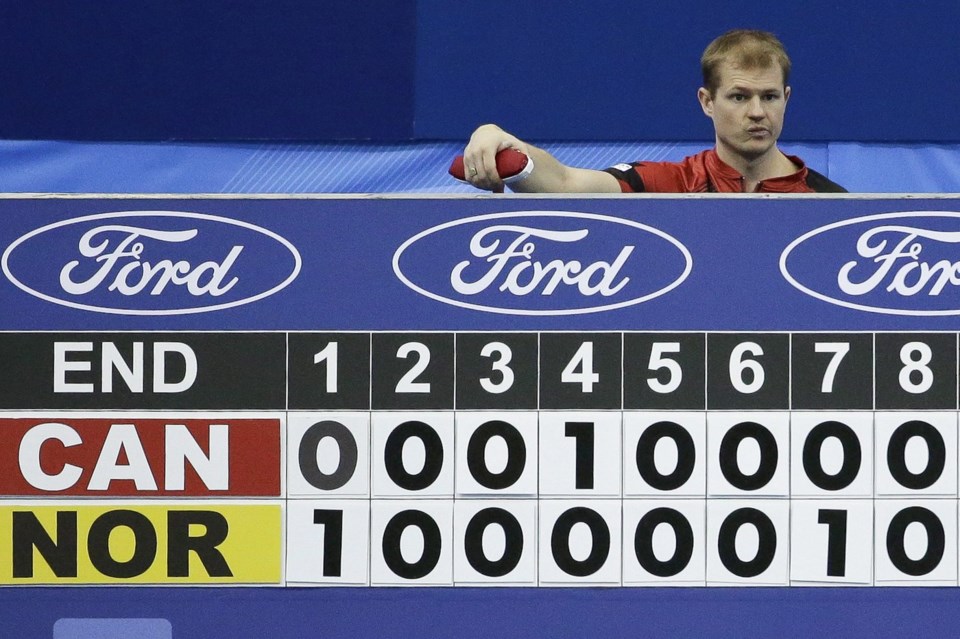As far as curling experiments go, a new rule that will be used at the next Grand Slam competition looks like a doozy.
Organizers plan to test a setup that will see a team lose hammer after a second consecutive blank end. The mid-season change, an attempt to boost scoring and entertainment, should have a significant impact on team strategy.
"I'm excited that they're trying something," said Curling Canada chief executive officer Nolan Thiessen. "It's going to change the game. I see a lot of scoreboard management now just because the hammer means so much."
A spokeswoman for the five-event circuit, which has been a testing ground for game tweaks in the past, confirmed the change will come at the Jan. 14-19 WFG Masters.
"We will evaluate following that event if it鈥檚 a change we want to implement permanently," Grand Slam events manager Jenni Cram said in an email.
The decision was finalized during the recent Kioti National at Mary Brown's Centre in St. John's, N.L.
A packed house eager to cheer on local favourite Brad Gushue watched as Winnipeg's Mike McEwen started with hammer and kept it for three straight blank ends.
"I get it. You take an arena with 6,000 people and it got really quiet," said Team Brad Jacobs coach Paul Webster, a former national development coach with Curling Canada. "However, from a pure curling and performance standpoint, there's (so) many great shots.
"I don't think the armchair quarterbacks at home sometimes realize how many great shots (have to be made) to sometimes create these blank ends."
McEwen ended the scoring drought with a single in the fourth end. He went on to post a 4-3 victory in the round-robin game.
Scotland's Bruce Mouat posted a 5-3 win over Jacobs, from Sault Ste. Marie, Ont., in the men's final that week. Ottawa's Rachel Homan took the women's crown with a 6-5 victory over Sweden's Anna Hasselborg.
The Grand Slam series used the five-rock rule for several years before the World Curling Federation voted to adopt it for widespread use in the 2018-19 season.
The goal was to have more rocks in play and fewer blanks while giving teams more of a chance to make comebacks. This latest change is the first step in a process that curling observers will watch with interest.
"I like the idea," Gushue said via text message. "Hate watching teams that just want to blank. Going (to) force them to play a little more."
However, the so-called double-blank rule does raise some concern that it may lead to an approach that actually limits excitement with fewer rocks in play.
"I believe it will lead to a different type of boring curling," curling statistician Gerry Geurts said via text. "All defence without the hammer."
Webster, meanwhile, said the best teams will figure out a way to make the rule work for them, or "more importantly, sometimes not work for their opponents."
"As a curling fan, I'd kind of like to see what it does," he said in a recent interview. "But I'm more concerned that we might be fixing one perceived problem with another one and we just don't know what it looks like."
Geurts, the president of the CurlingZone website, feels the simplest solution is to boost the stone count in the free-guard zone.
"Go straight to seven rock and/or expand the no-hit rule to rocks in the house as well," he said.
The Guelph stop is the penultimate event on the Grand Slam circuit.
The season-ending Players' Championship is set for April 8-13 in Toronto.
"Is this the rule to create more scoring? I'm not totally sure about that," Webster said of the hammer experiment. "But as a curling fan, would I love to see an 8-7 Mouat versus Jacobs final? (Heck) yeah.
"That would be great. Honestly that would be amazing."
This report by The Canadian Press was first published Dec. 12, 2024.
Follow @GregoryStrongCP on X.
Gregory Strong, The Canadian Press




